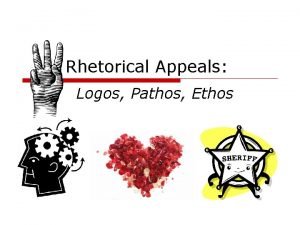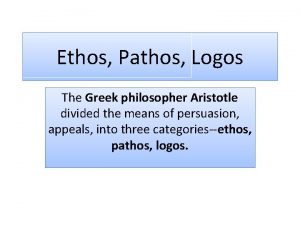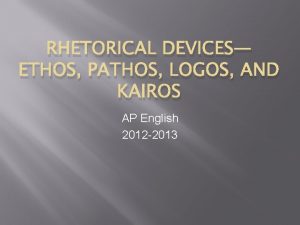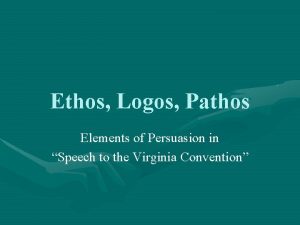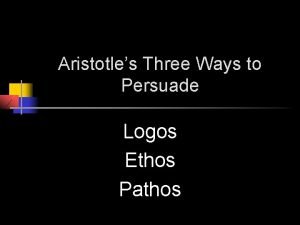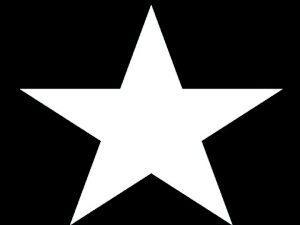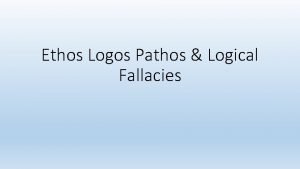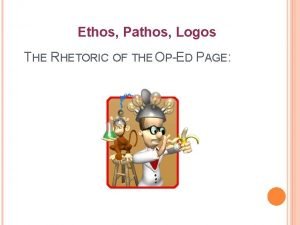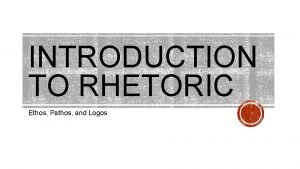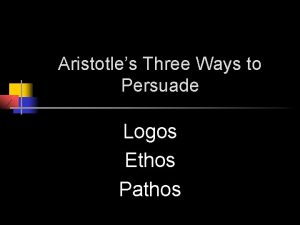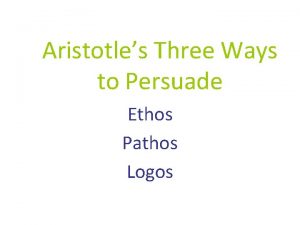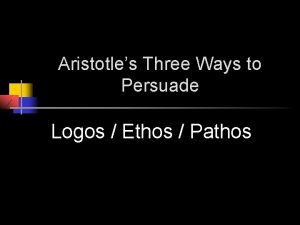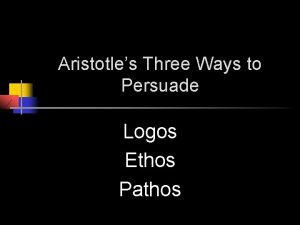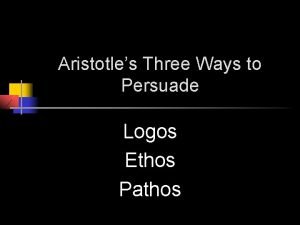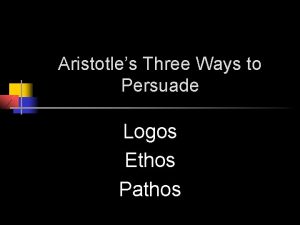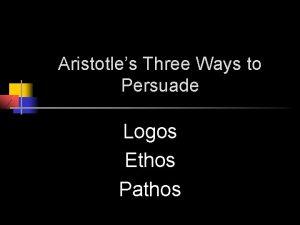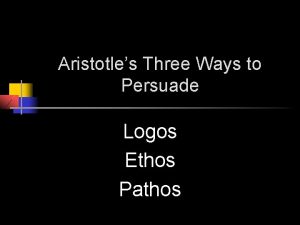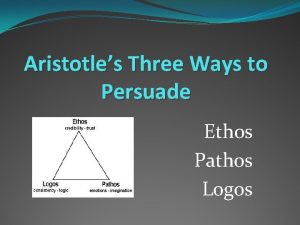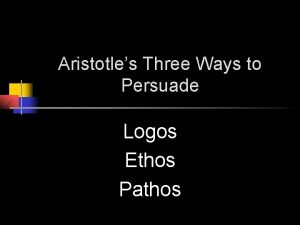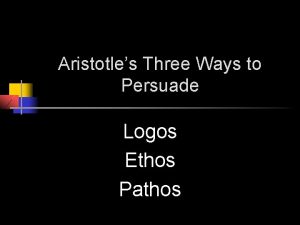Aristotles Three Ways to Persuade Logos Ethos Pathos













- Slides: 13

Aristotle’s Three Ways to Persuade Logos Ethos Pathos

Who is Aristotle? Aristotle (384 -322 BCE) is the most notable product of the educational program devised by Plato. Aristotle wrote on an amazing range of subjects, from logic, philosophy, and ethics to physics, biology, psychology, politics, and rhetoric.

What is rhetoric? Rhetoric is the art of persuasion. It includes, but is not limited to, figurative language, appeals to the reader, and how an author uses diction.

What is logos, ethos, and pathos? Logos = Logic Ethos = Ethics, Credibility Pathos = Emotions (Passion)

Logos • • Logos is an argument based on facts, evidence and reason. Using logos means appealing to the reader’s sense of what is logical.

Logos Example Genetically modified seeds have caused poverty, hunger, and a decline in biodiversity everywhere they have been introduced, so there is no reason the same thing will not occur when genetically modified corn seeds are introduced in Mexico.

Logos Example 44% of schools said that the condition of their physical buildings interfered with learning in some capacity. Most commonly to blame for the interference is air conditioning. Principals reported more interference among portable buildings where such elements as lighting, air quality, noise control, and size of the rooms caused concerns.

Ethos is an argument based on character. • Using ethos means the writer or speaker appeals to the audience’s sense of moral behavior (sense of right and wrong). • It can also mean that the writer or speaker presents himself or herself to the audience as credible, trustworthy, or honest.

Ethos Examples O Sinner! Consider the fearful Danger you are in: 'Tis a great Furnace of Wrath, a wide and bottomless Pit, full of the Fire of Wrath, that you are held over in the Hand of that God, whose Wrath is provoked and incensed as much against you as against many of the Damned in Hell: You hang by a slender Thread, with the Flames of divine Wrath flashing about it, and ready every Moment to singe it, and burn it asunder… -Sinners in the Hands of an Angry God

Ethos Example Dear Basketball, From the moment I started rolling my dad's tube socks And shooting imaginary Game-winning shots In the Great Western Forum I knew one thing was real: I fell in love with you. -Kobe Bryant

Pathos is an argument based on feelings. Using pathos means appealing to readers’ emotions and feelings.

Pathos Example We shall not flag or fail. We shall go on to the end. We shall fight in France, we shall fight on the seas and oceans, we shall fight with growing confidence and growing strength in the air, we shall defend our island, whatever the cost may be, we shall fight on the beaches, we shall fight on the landing grounds, we shall fight in the fields and in the streets, we shall fight in the hills. We shall never surrender. —Winston Churchill, speech to the House of Commons, June 4, 1940

Pathos Example A free bird leaps on the back of the wind and floats downstream till the current ends and dips his wing in the orange sun rays and dares to claim the sky. But a bird that stalks down his narrow cage can seldom see through his bars of rage his wings are clipped and his feet are tied so he opens his throat to sing. -Caged Bird by Maya Angelou
 Ethos, pathos and logos
Ethos, pathos and logos Ethos pathos logos greek
Ethos pathos logos greek Ethos, pathos logos worksheet doc
Ethos, pathos logos worksheet doc Ethos paragraph example
Ethos paragraph example We are marshall speech ethos pathos logos
We are marshall speech ethos pathos logos Appel former
Appel former Logos ethos pathos kairos examples
Logos ethos pathos kairos examples Ethos speech definition
Ethos speech definition Ethos pathos logos kairos
Ethos pathos logos kairos Logos example
Logos example Ethos
Ethos Ethos pathos logos fallacies
Ethos pathos logos fallacies Ethos, pathos, logos quiz worksheet
Ethos, pathos, logos quiz worksheet Anecdote ethos pathos logos
Anecdote ethos pathos logos
